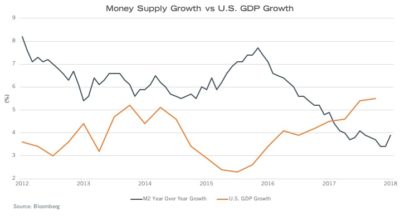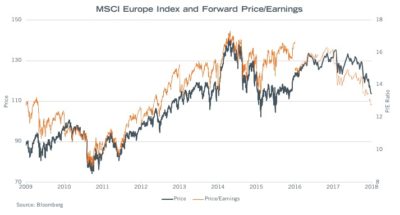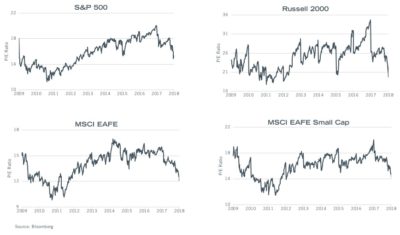Investors Busness Daily 2018 Market Review and Look Ahead to 2019

2018 was a punishing year for most investors, with negative returns from almost all asset classes. Stocks lost value in almost all major global regions, and the U.Southward. dollar appreciated against nigh currencies, amplifying non-United states of america losses. Bonds more often than not lost value as yields rose around the globe, and most commodities also declined in value. The 4th quarter of 2018 saw these losses mount, as an explosive sell-off in December triggered a 14% decline for U.S. large-cap stocks (as measured past the S&P 500 index), a 20% decline for U.S. small caps (Russell 2000 index), and a 13% decline for international (MSCI EAFE index). Japanese savers outperformed the world, as the net gain on the yen (approximately 2% versus the dollar) appears to have outperformed all other conventional investments.
It is reasonably axiomatic every bit a Monday morning quarterback how to look at the developments over the course of the year. Following a blow-off top at the beginning of 2018, tighter liquidity, poor news flow, and a higher risk-free interest rate pulled all manner of financial assets lower. In 2017, markets moved north in a synchronized manner with historically low volatility. The global economical outlook was hailed as being unusually sunny and pleasant, and abundant liquidity pushed global equity markets to new post-GFC highs in Jan 2018. Post-obit this brief euphoria, markets resided in negative territory for eight months of the twelvemonth and plunged in altogether in the fourth quarter, with record mutual fund outflows. Full losses pushed into twenty%+ bear markets for all equity asset classes excepting the S&P 500, which bottomed at -nineteen%. The declines are quite like to the 2011 market rout, proximally acquired by a monetary shock (Euro crisis, U.Southward. sovereign debt downgrade), albeit times take changed seven years later.
What Acquired the Rout?
 I believe the primary crusade was a combination of elevated expectations at the onset of 2018 and deteriorating money supply growth. With U.S. nominal Gdp growth in backlog of 5% for much of 2018, and money supply growth clocking in at ~3% due to monetary tightening by the U.South. Federal Reserve, liquidity came out of stocks and into the non-financial economy, a miracle called the "Marshallian K" (named afterward an early 20th century economist). In Marshallian terms, we had a money supply arrears and the plug variable are outflows from fiscal assets – which explains the poor functioning from within stocks, bonds, bolt, and currencies. A poor political tone and the ongoing threat of a global trade war escalation (with no particularly articulate path to resolution) did not help sentiment and affected investor behavior. The threat of tariff escalation may take bunched some capital goods and finished production orders over the course of the year, creating not-linear demand spikes and declines that an increasingly quantitatively driven fiscal system does not compute with ease. Just trade racket and other questions of political intentions were also function of the landscape in 2017 – it'due south difficult to argue with consistency that these became altogether stronger factors in 2018.
I believe the primary crusade was a combination of elevated expectations at the onset of 2018 and deteriorating money supply growth. With U.S. nominal Gdp growth in backlog of 5% for much of 2018, and money supply growth clocking in at ~3% due to monetary tightening by the U.South. Federal Reserve, liquidity came out of stocks and into the non-financial economy, a miracle called the "Marshallian K" (named afterward an early 20th century economist). In Marshallian terms, we had a money supply arrears and the plug variable are outflows from fiscal assets – which explains the poor functioning from within stocks, bonds, bolt, and currencies. A poor political tone and the ongoing threat of a global trade war escalation (with no particularly articulate path to resolution) did not help sentiment and affected investor behavior. The threat of tariff escalation may take bunched some capital goods and finished production orders over the course of the year, creating not-linear demand spikes and declines that an increasingly quantitatively driven fiscal system does not compute with ease. Just trade racket and other questions of political intentions were also function of the landscape in 2017 – it'due south difficult to argue with consistency that these became altogether stronger factors in 2018.
No Powell Put?
Stock markets since the 1987 crash have grown accustomed to immediate Fed soothing actions – in the form of words or deeds – once stresses emerged. This has not necessarily prevented comport markets or the great crash of 2008 (and may have contributed to some of the moral laxity that precipitated the sharp financial declines of the 2000s), but it has been the norm. With markets under cloth pressure in early December, the Fed nether new Federal Reserve chair Jerome Powell surprised investors with a program to continue its rest sheet roll off and multiple forecasted 2019 interest rate increases. This roiled already poor confidence and fed into a computer-driven and taxation-loss selling motivated rout, climaxing on Christmas Eve. Equally monetary policy renormalizes, it is unclear whether equities and bonds need to reprice the absence of a Fed put choice in coming years, or at to the lowest degree a higher threshold for it.
Exterior the U.S., international markets fared poorly throughout the yr. Non-U.South. markets were already in the red on a yr-to-date basis by the beginning of the fourth quarter, and proceeded to fall in lockstep with U.S. stocks as markets sold off in an increasingly disorderly fashion. European equities retraced fully the advance from 2016 lows, while Japanese stocks brutal back to early 2017 levels at the end of the year. A stronger dollar and higher competitive involvement rates in developed markets heighten funding costs for Emerging Markets, leading to capital outflows and currency pressure. In all probability, the same negative drivers of elevated expectations and diminishing coin supply growth drove asset prices lower. However, a poorer growth narrative was also a critical cistron.
Emerging Markets as an asset grade and growth engine have come up to be dominated by People's republic of china, whose size and economic depth dwarves the rest of the EM universe. China's economy remains a hybrid of land control and government-sponsored companies, along with highly competitive gratuitous-enterprise companies. The financial system behind this is opaque, with inconsistent regulation and business practices. In mid-2018, every bit part of efforts to limit capital outflows and systemic risks, the Chinese government cracked downward on shadow lending businesses and other greyness market financial schemes. Lending through these channels declined by over 70% by some estimates during the year. In economical terms, this was a moderate sized "budgetary shock". Chinese buying patterns for big ticket items such equally cars, watches, and apartments declined materially in response to less available financing. Chinese auto sales declined by as much as iv mm units from early on 2018 forecasts (to the 24 mm range from a 28 mm unit level) – playing havoc with supply bondage for auto parts, semiconductor chips, and other materials.
People's republic of china and the U.S. are the world's engines of economic growth, equally the residuum of the world is either not big plenty or too stagnant to matter appreciably. China'southward longer-term growth trajectory is jump to exist lower than what it has been to engagement, equally moving farther upwards into college value-added product and services industries is not hands centrally planned. Investors rightly fear that if Chinese growth becomes outright stagnant, so too will be the end markets for a variety of key industrial, commodity, and technology products. Visible signs of slowing, fifty-fifty if somewhat self-induced in 2018, are cause for caution, as is an aggressive Fed tightening and balance canvas run off in the U.South. Net, information technology seems that for the visible hereafter, cyclical businesses will keep to central off the direction of the world's two largest economies.
 European stock market functioning was particularly poor for 2018, with the MSCI Europe alphabetize declining by 17% in dollar terms at year'southward end, and by 25% from highs reached in January 2018. In raw stock cost terms, European averages have failed to advance since August 2009 (as measured in dollars)…an astonishing record of futility. This statistic casts the discussion in a somewhat darker calorie-free than is entirely fair, equally European dividend yields are high (iii.85% currently), and the Euro currency has gone from an overvalued land in 2009 to an undervalued state versus the U.S. dollar. European economic growth rates are structurally lower relative to the U.South. and Asia, largely a function of near-zero population growth, high wealth levels already, and a lot of dependence on exporting to other corners of the world. Loosely speaking, economical potential is nigh half of American economic potential, if not a flake less. European growth rates fell from nigh ii% in belatedly 2017 to borderline flat levels now. Nosotros have seen this design earlier; it is not necessarily a prelude to a wrinkle, merely more consistent with low structural growth in the region. Nonetheless, coupled with governments in the U.K. and Italia's best efforts to scare investment capital from the region, stocks and valuations plunged in 2018. The net result was a contraction in the P/Eastward multiple of the European market to the 12x level, concluding seen during the peak Euro-crisis period.
European stock market functioning was particularly poor for 2018, with the MSCI Europe alphabetize declining by 17% in dollar terms at year'southward end, and by 25% from highs reached in January 2018. In raw stock cost terms, European averages have failed to advance since August 2009 (as measured in dollars)…an astonishing record of futility. This statistic casts the discussion in a somewhat darker calorie-free than is entirely fair, equally European dividend yields are high (iii.85% currently), and the Euro currency has gone from an overvalued land in 2009 to an undervalued state versus the U.S. dollar. European economic growth rates are structurally lower relative to the U.South. and Asia, largely a function of near-zero population growth, high wealth levels already, and a lot of dependence on exporting to other corners of the world. Loosely speaking, economical potential is nigh half of American economic potential, if not a flake less. European growth rates fell from nigh ii% in belatedly 2017 to borderline flat levels now. Nosotros have seen this design earlier; it is not necessarily a prelude to a wrinkle, merely more consistent with low structural growth in the region. Nonetheless, coupled with governments in the U.K. and Italia's best efforts to scare investment capital from the region, stocks and valuations plunged in 2018. The net result was a contraction in the P/Eastward multiple of the European market to the 12x level, concluding seen during the peak Euro-crisis period.
It has been a long and dark "lost decade" for European stocks, dominated more by exasperating sovereign nuisances than great corporate stories of value creation. The survivors are, we think, some very strong businesses on balance. Central uncertainties that have stretched investor patience to the limit are poised to resolve in 2019, which ought to unlock what appears to be trapped value, broadly speaking.
Marketplace Structure: "Mr. Market place" Does Not Alive Here Anymore
"Mr. Market" is a character created by investor Benjamin Graham, and frequently cited past Warren Buffett in his older writings. Per Wikipedia, "Graham asks the reader to imagine that he is one of the two owners of a business, forth with a partner called Mr. Market. The partner frequently offers to sell his share of the business concern or to buy the reader'due south share. This partner is what today would be called manic-depressive, with his judge of the business concern'due south value going from very pessimistic to wildly optimistic. The reader is always free to decline the partner's offer, since he will before long come up dorsum with an entirely different offering." Buffett similarly referenced Mr. Market to explicate the sharp shifts in stock market sentiment, risk appetite, and short term investing fads. I always pictured Mr. Market to be a Woody Allen-similar character – a bit nerdy, neurotic, reasonably well-educated, yet chronically inconsistent and prone to whims. Buffett seemed to view the character more as a farm owner down the route who was e'er in the market for farmland, but wildly inconsistent in what he might pay. Perhaps he had a particular fellow in mind.
A threshold will be crossed at some point in 2019, as indexed assets will breach 50% of the total U.South. stock marketplace (disallowment some sharp shift in this trend which I currently don't meet occurring). Mr. Market place holds convictions as to the value of businesses and what kinds might appreciate, fifty-fifty if these are fluid and inconsistent. A passive index does not possess such convictions, as in that location is no price-discovery or reaction to changes in business organization fundamentals. Rather, an alphabetize volition essentially piggyback off the decisions of an ever-decreasing pool of agile investors. In a mood shift, all stocks are for sale, or all stocks are to be bought, with fiddling in between. In a earth that now seems rather distant, retail investors and tendency-hugging common funds, tended to personify the neurotic and whimsical features of Mr. Market, frequently piling into crowded forms of speculation simply to change course and risk appetite, often with poor timing.
While not nevertheless eradicated completely from market structure, the omnipotence of index flows and the impact on market pricing signals is becoming difficult to cast aside as inconsequential. At more than half of disinterestedness ownership, a liquidation conclusion by Mr. Index Funds would overwhelm what'south left of liquid investment upper-case letter, leading to some very significant questions about the market's capacity to clear positions. This is evident in market breadth statistics from the 4th quarter market flush. There have been three singled-out (but curt-lived) global equity conduct markets since the GFC low in early 2009: the 2011 Eurozone crunch, the 2015-16 time menstruation (dominated by a stronger dollar and commodity price declines), and the 2018 decline, with Fed Quantitative Tightening (QT), interest rate renormalization, and trade fears probably going downwardly every bit the likely causes. In the other two prior comport markets, articulate testify of credit stress emerged in the most affected assets, such as Mediterranean sovereign debt in 2011, or U.S. high yield debt for article-oriented companies in 2015. There has been scant bear witness of credit stress this fourth dimension around – simply a poor tone and loss of up momentum. At the 2011 and 2015 market lows, most 30% of stocks hit their depression for the year at the market low, and ~70% of stocks traded below their 200-twenty-four hour period moving averages. In December 2018, over fifty% of stocks hit their lows for the yr, and over 90% fell beneath 200-day moving averages…suggesting at that place was nowhere to hibernate and that greenbacks was the just practical defense mechanism. Imagine if there had been credit stress! Abroad from market movements and an incapacity to absorb sudden liquidity flows out the door, at that place are mini-crashes on nearly a daily basis, equally quantitative and computer-driven programs button private stocks around news events, earnings releases, and changes in ETF flows. It doesn't look like or feel like Mr. Market'south frequent mood shifts. It feels like something else, a robot curating news stories and pushing on momentum, or short term derivatives contracts being hedged and re-hedged into thinner and thinner liquidity.
From the lens of the Mr. Market allegory, our quirky friend downward the route has become old and lost a few steps, and seems to have a chronic cough that just doesn't sound very good. He is withal the same guy and yet non really the same anymore, transacting much less frequently and much less interested in being bothered. His demise is not imminent, merely this young man may not have that much longer with us; it's hard to say. While ever imperfect, the pricing and feedback machinery that public equity markets have represented for the better part of two centuries does work to aqueduct majuscule and breathtaking rewards for success to those with the all-time ideas, products, and business execution, propelling the inherent value of business formation and expansion forward broadly. The passive blob that is replacing it seems to be doing a great job at rewarding size, leading to a tiptop-heavy market prone to volatility episodes on short find. Information technology does not take a nifty experience to information technology.
2019+ Investment Views
Nosotros are optimistic that returns in 2019 and perhaps into 2020 will be a practiced deal improved, if for no ameliorate reason so the starting indicate is notably low. Just squint at the following charts of P/East multiples for the U.S. and International equity markets. All have reverted dorsum to 2012-2013 levels, a time period that was notably bonny for forrad returns.

At the stop of the third quarter, nosotros wrote that current markets are reminiscent of broader global market weather condition in late 2011-2012, when valuations remained compressed for merely nigh everything, from tech to banks to industrials to durable appurtenances. Non much changed in Q4, it merely got more than astute! Over the course of 2019, we anticipate several current hangnails will exist resolved, such as Brexit, a populist government in Italy, and the ECB's elevator-off from NIRP monetary policy (NIRP is being more widely criticized as ineffectual and contractionary from a diverseness of economists across the ideological spectrum). It's a bit less articulate whether Communist china and the Trump assistants tin agree on a merchandise package, and as well a fleck less articulate whether the Federal Reserve will halt interest charge per unit hikes and remainder sheet shrinkage entirely in 2019, though they seem to exist on hold for the starting time half. If, equally argued, a deficiency of money supply growth relative to nominal Gross domestic product growth acted to depict capital out of financial avails, some combination of slowing U.Due south. GDP, amend coin supply growth from a tranquillity Fed, and better money supply growth ex-The states would human action as positive catalysts throughout the year.

Cambiar President Brian Barish reflects dorsum on a volatile 2018 and outlook for this twelvemonth.
Thanks for your continued confidence in Cambiar Investors.
Savor our content? Please follow.
Disclosures
Certain information contained in this communication constitutes "forward-looking statements", which are based on Cambiar'southward behavior, likewise as certain assumptions concerning time to come events, using data currently available to Cambiar. Due to market risk and uncertainties, actual events, results or functioning may differ materially from that reflected or contemplated in such forward-looking statements. The information provided is not intended to exist, and should not exist construed equally, investment, legal or tax advice. Nix independent herein should be construed as a recommendation or endorsement to buy or sell any security, investment or portfolio resource allotment.
Whatsoever characteristics included are for illustrative purposes and accordingly, no assumptions or comparisons should be made based upon these ratios. Statistics/charts may exist based upon tertiary-party sources that are accounted reliable; however, Cambiar does not guarantee its accuracy or abyss. As with any investments, there are risks to be considered. Past functioning is no indication of future results. All material is provided for advisory purposes only and there is no guarantee that whatsoever opinions expressed herein will be valid across the engagement of this communication.
Source: https://cambiar.com/4q18-insights/
0 Response to "Investors Busness Daily 2018 Market Review and Look Ahead to 2019"
Post a Comment